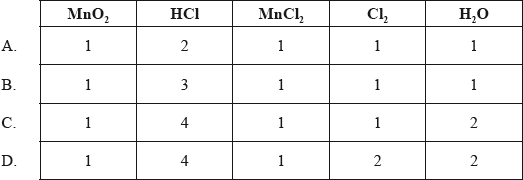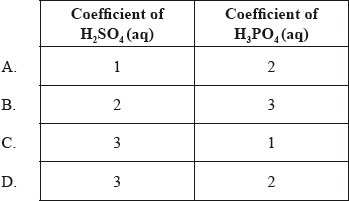Question
Which is the correct equation for the electrolysis of molten sodium chloride?
A. \(2NaCl(l) → 2Na(l) + Cl_2 (g)\)
B. \(2NaCl(s) → 2Na(s) + Cl_2 (g)\)
C. \(2NaCl(l) → 2Na(s) + Cl_2 (g)\)
D. \(2NaCl(aq) → 2Na(s) + Cl_2 (g)\)
▶️Answer/Explanation
Markscheme: A
The electrolysis of molten sodium chloride (\(NaCl\)) involves the breaking down of the compound into its constituent elements, sodium (\(Na\)) and chlorine (\(Cl_2\)), through the application of an electric current.
The balanced chemical equation for the electrolysis of molten sodium chloride is:
\[ 2NaCl(l) \rightarrow 2Na(l) + Cl_2(g) \]
This process takes place in a molten state, meaning that the sodium chloride is melted to form a liquid. The electric current is passed through the molten salt, leading to the reduction of sodium ions (\(Na^+\)) to form sodium metal (\(Na\)) at the cathode and the oxidation of chloride ions (\(Cl^-\)) to form chlorine gas (\(Cl_2\)) at the anode.
Question
Nitroglycerine, \({{\text{C}}_3}{{\text{H}}_5}{{\text{N}}_3}{{\text{O}}_{\text{9}}}\), can be used in the manufacture of explosives. What is the coefficient of \({{\text{C}}_3}{{\text{H}}_5}{{\text{N}}_3}{{\text{O}}_9}({\text{l)}}\) when the equation for its decomposition reaction is balanced using the lowest whole numbers?
___ \({{\text{C}}_3}{{\text{H}}_5}{{\text{N}}_3}{{\text{O}}_9}{\text{(l)}} \to \) ___ \({\text{C}}{{\text{O}}_2}{\text{(g)}} + \) ___ \({{\text{H}}_2}{\text{O(l)}} + \) ___ \({{\text{N}}_2}{\text{(g)}} + \) ___ \({{\text{O}}_2}{\text{(g)}}\)
A. 2
B. 4
C. 20
D. 33
Answer/Explanation
Markscheme
B
Examiners report
One respondent stated that this question was particularly difficult. Although the question was challenging, 66.89% of candidates did manage to get the correct answer B. The question was the ninth hardest question on the paper.
Syllabus sections
Question
What are the coefficients of \({{\text{H}}_{\text{2}}}{\text{S}}{{\text{O}}_{\text{4}}}{\text{(aq)}}\) and \({{\text{H}}_{\text{3}}}{\text{P}}{{\text{O}}_{\text{4}}}{\text{(aq)}}\) when the following equation is balanced using the smallest possible whole numbers?
___ \({\text{C}}{{\text{a}}_{\text{3}}}{{\text{(P}}{{\text{O}}_{\text{4}}}{\text{)}}_{\text{2}}}{\text{(s)}} + \) ___ \({{\text{H}}_2}{\text{S}}{{\text{O}}_4}{\text{(aq)}} \to \) ___ \({\text{CaS}}{{\text{O}}_4}{\text{(s)}} + \) ___ \({{\text{H}}_3}{\text{P}}{{\text{O}}_4}{\text{(aq)}}\)

Answer/Explanation
Markscheme
D
Examiners report
[N/A]
Syllabus sections
Question
Which coefficients would balance this equation?
__ \({\text{Mn}}{{\text{O}}_2} + \) __ \({\text{HCl}} \to \) __ \({\text{MnC}}{{\text{l}}_2} + \) __ \({\text{C}}{{\text{l}}_2} + \) __ \({{\text{H}}_2}{\text{O}}\)

Answer/Explanation
Markscheme
C
Examiners report
In spite of a concern on the part of one teacher that this question was too difficult, this was one of the questions that students found easiest, with a Difficulty Index of 94%; hence it provided a nice easy start to settle students into the paper.
Question
What are the coefficients of \({{\text{H}}_{\text{2}}}{\text{S}}{{\text{O}}_{\text{4}}}{\text{(aq)}}\) and \({{\text{H}}_{\text{3}}}{\text{P}}{{\text{O}}_{\text{4}}}{\text{(aq)}}\) when the following equation is balanced using the smallest possible whole numbers?
___ \({\text{C}}{{\text{a}}_3}{{\text{(P}}{{\text{O}}_4}{\text{)}}_2}{\text{(s)}} + \) ___ \({{\text{H}}_2}{\text{S}}{{\text{O}}_4}{\text{(aq)}} \to \) ___ \({\text{CaS}}{{\text{O}}_3}{\text{(s)}} + \) ___ \({{\text{H}}_3}{\text{P}}{{\text{O}}_4}{\text{(aq)}}\)

Answer/Explanation
Markscheme
D